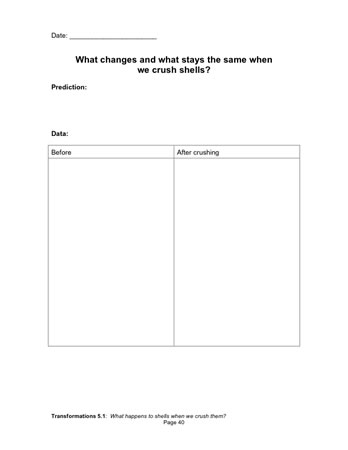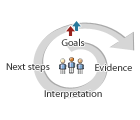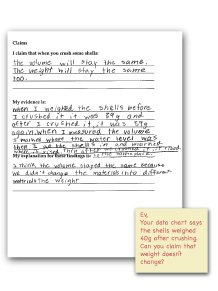What happens to shells when we crush them?
Plan Investigation 5.1
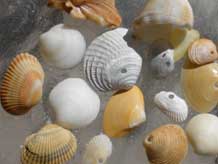
Broken rocks … weathered cliffs … eroded riverbanks … dynamited roadbeds. Earth materials can change — that's obvious; indeed, children can observe such changes with their own eyes. What is less obvious is that despite all these physical changes there remains a finite and constant amount of matter on Earth — and in the Universe.
Formative Assessment
Available online at inquiryproject.terc.edu
In this investigation students are introduced to the idea of conservation of matter through a classroom activity that mimics the long-term effects of weathering. After recording information about a handful of shells, including their weight and volume, students crush the shells underfoot. As they examine the crushed pieces, students record what has changed and what has remained the same.
By the end of the investigation students will see that while the size and shape of the shell pieces have changed, the weight and volume remain the same. They consider whether this is likely to be true for transformations of other earth materials.
Learning Goals
- Understand that when earth materials are transformed, some properties remain the same while other properties change
- Consider whether weathering causes earth materials to disappear
| Sequence of experiences | ||
|---|---|---|
| 1. Ask the question | All Class | 5 Mins |
| 2. Predict what will happen | Small Groups | 15 Mins |
| 3. Collect data and check predictions | Pairs | 15 Mins |
| 4. Make Meaning | Discussion | 10 Mins |
Materials and Preparation
For the class:
- Post the investigation question in a place where all students can see it.
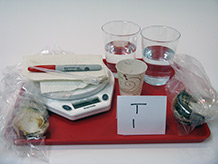
For each tray:
- 2 sandwich bags, each filled with approximately 50 grams of shells
- 4 additional sandwich bags
- 2 20oz cups approximately half full of water
- 1 3oz cup of water
- 1 fine-tip permanent marker
- 1 digital scale
- 1 pipette
- 4 paper towels
Concept Cartoon

The Additive Property Concept Cartoon is typically used as a formative assessment at the end of this investigation.
Can students use data to support a claim about what changes and what stays the same when you crush some shells and provide a possible explanation?
Look at students’ predictions and reasoning in the Crushing Shells notebook page for evidence. Then look at their data, claims, and explanations.
To interpret the work, ask yourself:
- Are claims backed up by recorded data?
- Are the results the same or different from the prediction?
- Does the explanation include the idea that the material (shell) was the same after crushing and that no new material was added or taken away?
A next step could be to ask, “Do you think the result would be the same if we used a different material, such as rocks, leaves, wood, etc.?”
1. Ask the question
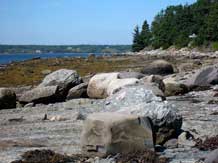
Let students know they are nearing the end of their work with earth materials. In this last part of their study, they will investigate what happens when natural forces change earth materials.
Have students close their eyes for a moment and then call up a couple of different scenarios.
- Imagine you are standing on top of a mountain, and you can stand there for millions of years. The wind blows, the rain comes down, water freezes and thaws. Gradually the mountain wears away. Where does it go? How much is left? Does it actually disappear?
- Imagine you are the ocean, pounding against the cliffs in some faraway place. You are a wild ocean, and you pound away for thousands of years. What happens to the rocks? To the sand? To the soil? Where does it go? How much is left? Does it actually disappear?
Listen to the answers, and remind students that they learned a word for this kind of "wearing away" of earth materials earlier in the unit. The process is called weathering and it takes a very, very long time. As earth materials weather, they break into smaller and smaller pieces — like the tiny bits of mica and quartz students saw in their rocks a couple of weeks back. Now pose a new scenario.
- Imagine you have a bag full of shells and you smash them all to bits, like a giant wave or a big wind, but working much faster. What happens to the shells? What changes? What remains the same?
- Does the weight change? Does the volume? What about the material itself?
Point out the investigation question:
What happens to shells when we crush them?
Let students know they are about to find out for themselves.
2. Predict what will happen
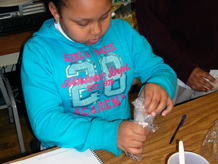
Distribute a tray of materials to each group, and then hold up a bag of shells.
- Think about this bag of shells as they are right now, before they are crushed. If we keep them in this bag and crush them by stepping on them, what do you predict will change and what will stay the same?
Give students a few minutes to record their predictions in their science notebooks [What changes and what stays the same when we crush shells?]. Make sure students explain the reasoning behind each prediction: Why do they think what they think?
After the students have finished recording their predictions, ask them to share their ideas in their small groups. What properties of the shells are they thinking about? Many students will think of color, size, and shape. Others may mention weight and volume. Some may think of smell, texture, or luster.
As you circulate among the groups, take note of what students predict will change and what they predict will stay the same.
- How can you check your predictions? What kind of data would you need to collect?
Bring the ideas together in a list of the students' predictions. Make sure weight and volume are on the list, and that each prediction has a corresponding idea for how to test it, as in the chart below.
| Some likely student predictions | How to check predictions |
|---|---|
| The weight will [or will not] change. | Weigh shells before and after crushing. |
| The sizes of the pieces will change. | Trace one shell before crushing the bag of shells. |
| The volume of the shells themselves will [or will not] change. | Measure shell volume before and after crushing. |
| The color will [or will not] change. | Save a sample of uncrushed shell for comparison. |
Tell students you’d like each team of students to check the weight and volume of the shells, along with two additional properties, then set them to work.
3. Collect data and check predictions
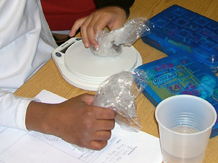
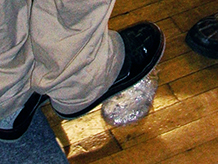
Students engage in a three-step investigation. First they collect data on the unbroken shells, then they crush them, then they collect data on the crushed shells to check their predictions. They record data in their notebooks as they go along [Crushing shells claims].
All students will collect data on weight and volume, using the digital scale and the water displacement technique they learned earlier in the unit. Let them know they should collect this weight and volume data first. As time allows, students can collect data to check their predictions about other properties they have chosen to investigate, such as color, size, shape, or smell.
There may not be enough time for every group to gather data to check every prediction. Let students know they should work carefully and not hurry; the class will share their results at the end.
As you circulate among the groups, make sure students collect all the data they need before they crush the shells. Students will need to triple-bag the shells before crushing them, and while they should weigh the shells in the bags, they will need to take them out to collect the volume data (see accompanying note).
A Likely Sequence of Investigation:
- Weigh the shells, along with the three sandwich bags, and record the initial weight.
- Check characteristics such as initial size, color, shape, etc., and record the results.
- Check volume using the water displacement method and record the results.
- Dry the shells with the paper towels.
- Triple-bag and crush the shells by stepping carefully but forcefully on the bag several times. Some shells may not crush easily. These may remain uncrushed in the bag.
- Weigh the crushed shells in their triple bags and record the results.
- Check characteristics such as size of pieces, color, shape, etc. and record the results.
Share class data
Ask students to share their predictions and findings with the class, beginning with the weight and volume findings. As you record the results in a class list, make sure students specify the evidence that verifies or refutes their predictions.
What happened to weight and volume when we crushed some shells?
| Group | Weight | Volume |
|---|---|---|
| 1 | Stayed the same | Stayed the same |
4. Make meaning
Purpose of the discussion
The purpose of this discussion is to construct an explanation of what happens to the volume and weight of shells when they are transformed through crushing. The students’ explanation should be consistent with their observations and evidence . They also connect their shell crushing experience with the phenomena of weathering. Return to the investigation question for discussion.
Engage students in the focus questions
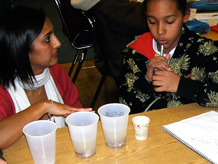
Students go out on a limb when they make a prediction and they are usually interested in the outcome of their data collection. When their predictions are not supported by data, some are willing to rethink their ideas based on these findings while others are reluctant to let go of their original ideas. Ask students to compare their predictions and the class data (refer to the group data table).
What happened to the shells when you crushed them?
- When you look back at your predictions, do any of these findings surprise you? Why?
Help students find relevance in today's investigation.
- How would you connect today’s findings to weathering in the natural world?
Listen for ideas about how shells are weathered by tides pushing them along on the shore, rolling them against each other, breaking off pieces here and there, and distributing the smaller pieces on the beach or in the waves. The shell weathers but it doesn’t go away; the smaller pieces just become more spread out across the beach and ocean floor.
Weight and volume stay the same: Unless some pieces of shell are lost in handling, crushing the shells will not result in a change of weight or shell volume. The bulk volume of the shells, on the other hand, is likely to become smaller. Although students will not measure bulk volume, you may wish to remind them of the concept and ask what they think has happened to bulk volume.
Point out that the plastic bags represent Earth. As shells and rocks and soils weather, the pieces get smaller and smaller but they are still on Earth — just as the shells remained in the bag after the students crushed them. The Earth does not lose any material when a shell is turned into dust; the material is transformed into something different, but no material is lost from Earth. The earth materials you see today will be here forever in some form or another.
Provide time for students to make claims in their notebooks [Crushing shells claims].
Summarize the discussion and recap the investigation
Summarize the discussion by having several students share (from their notebook) their claims, evidence, and explanations for what happens to shells when we crush them.
As you wrap up today's investigation, check for a beginning understanding of the following points:
- When an object is transformed, some things stay the same and other things change.
- When earth materials become weathered, they do not disappear; they keep their weight and volume but get spread out over a greater area.
- Earth is made up of a finite and constant amount of material.


